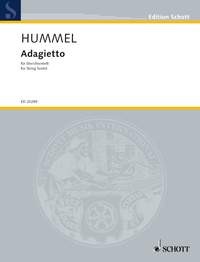Adagietto for string sextet, op. 75d (1978)

First
Performance : October 30, 1999, Güthersloh,
Stadttheater
Georg Döring / Wiebke Corßen / Beate Corßen / Gregor van
den Boom / Bertold Hummel / Michael Corßen
Duration: 6 Minutes
Publisher: Schott Music ED 20289 / ISMN: M-001-14994-5Misprint:
Bar 83: Vla. II, Vlc. I+II: 2nd half note pp
bar 125: Vcl. I+II: 2nd half note portato
Hummel
marked one score of the first edition in pencil ‘auch
chorisch besetzbar’.
In another score, he marked in pencil the following
passages in which a double bass could also play:
bars 11+12
bars 23-76
bars 82-86 (only the first half note)
bars 91-138
bars 159-160 (pizz. E in each case)
Double bass part:
Foreword (Schott Music)
Bertold Hummel
worked on his Adagietto for many years.
Originally conceived as an Elegy for Strings in
1965, it was transformed into an Adagietto for
String Sextet in 1978 and published for the
first time in 1993. Hummel undertook a further
arrangement of the composition in 1999 and participated
with musical friends in its first performance. In one of
the scores, the title is supplemented by the term "sacrale",
an indication of the religious background of this
composition.
"In a time
of increasing secularisation, the creative and no
doubt also the reproducing artist have the task of
pointing out to their contemporaries the
transcendental, the inexplicable and the unprovable.
The language of music - most effective perhaps in
reaching across world frontiers - has an especially
important role in this. Representations of suffering
and horror alone cannot be the inherent constituent of
a work of art. A reference to comfort and hope is
indispensable. Furthermore, life, nature, and, for the
believer, knowledge of God give cause enough for
praise and thanks."
This is how my
father once formulated his artistic conception. A
favourite adopted term of his, "musikalische Klangrede"
[musical speech), appears to me to be particularly well
implemented in the Adagietto.
Martin
Hummel Translation: Lindsay
Chalmers-Gerbracht
In his Adagietto
for string sextet, the variety results from the
playing in the two of each arrangement of violins,
violas and cellos.
A unisono of the first violin together with both cellos
begins in p, the melody rises in 12 bars to a ff
chord; immediately, it begins from the bottom again, but
now a tone higher, thus intensifying the effect. In
close intervals, the instruments join in continuing the
theme, increasing their volume to powerful chords or
breathing out quietly in pp. The motion of the parts is
generally homophonic, tension is created through the
immediately adjacent contrasts of pp and ff.
Dynamics of this kind prevail during the whole course of
the piece and take the listeners' breath away.
There is a counterweight to the ascending motion with
which the piece begins: a rhythmically lively second
motif appears, already introduced at the beginning as a
descending line in the second violin. In the course of
the Adagietto, it grows in independence, until
the piece comes to rest in ppp on a quietly
shining E major.
Hans Jürgen
Kuhlmann (in the programme booklet of
the ensembles "Il Cappricio", July 2003)
Press
Winnender Zeitung, 4th May, 2004
A 20th century work carried us away into a completely different world - the "Adagietto for String Quartet" by Bertold Hummel (1925 - 2002). Tone clusters and clouds of sound, expressive and full of dissonances, savoured by the instrumentalists to the last note. Then again sounds like an uproar or an unaltered repetition of a melody which seemed to come from another sphere. Pictorial atmosphere in the purest form. Seconds went by before the tension in the audience was released with the first applause.